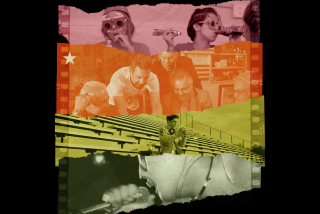‘Selena’: A Symbol of Today’s Cultural Ties
- Share via
My girlfriend loved Selena because the tejano star couldn’t quite roll her Rs in Spanish. I liked her because she wasn’t too proud to resort to English during Spanish-language interviews. “Como se dice cinnamon?” she once asked a Latin American TV reporter without a hint of embarrassment.
After she was murdered, nobody seemed able to place her culturally. Tom Brokaw called the U.S.-born Selena the “Mexican Madonna.” The Mexican music magazine Furia Musical ran an article on how the American singing sensation couldn’t speak Spanish all that well.
The marketing effort for “Selena,” Gregory Nava’s new movie about her life and death, offers Selena as the archetypal American story. And by all accounts it was. She was raised in suburban Corpus Christi, Texas, and became the instrument of her father’s frustrated artistic ambition. She had the dreamy exuberance of a suburban American teen. And, in the great American tradition of violence, her life was cut short by a bullet in the back.
But to Mexican Americans, Selena’s story is also one of the burden of leading hyphenated lives, and of the need to forge a place for ourselves between the dismissive Anglo American and Mexican mainstreams.
Selena Quintanilla Perez was an American girl who preferred disco to rancheras. She made it big singing in Spanish but dreamed of being an English-language “crossover” star.
Not too long ago, when Mexican American identity was still defined more by its roots than its branches, Latino cultural ambivalence was a source of shame for the children and grandchildren of immigrants. Mexicans called their English-speaking, Scooby-Doo-
watching American cousins pochos, which meant something like “watered-down Mexicans.”
But Selena’s tremendous popularity, in both the U.S. and Mexico, is a sign of the times. In her life and success, pocho no longer connotes a marginal position in a culture that was never fully ours but a growing pride in Mexican American hybrid status and the ability to sample and absorb the best from both sides of the border.
The buzz in Hollywood is that a success with this movie of Selena’s life will translate into more English-language, Latino-themed productions. Warner Bros. spent more money than usual trying to reach the Latino market with “Selena,” and the movie opened nationwide on 1,850 screens ($11.6 million).
A box-office hit, however, depends on the picture’s appeal to all audiences. In parts of the country that are rapidly Latinizing, Mexican American hybridity is already reaching the mainstream. In Los Angeles, English- and Spanish-language media are cross-pollinating. The leading 6 p.m. TV newscast in Spanish advertises on KPWR-FM (105.9), the English-language hip-hop station. The Galaxy, L.A.’s soccer team, runs English-language radio ads featuring accented voices. David Letterman’s eighth reason for not moving back to Los Angeles from New York was that after 11 years away from L.A., he finally managed to lose his Chicano accent.
In the movie “Selena,” Edward James Olmos, playing Selena’s father, tells the young Selena how difficult it is to be Mexican American. “We have to know about John Wayne and Pedro Infante,” he says.
But if Selena’s bio-pic hits big, Hollywood studios may realize that the great urban, ethnic American tales are no longer to be found on New York’s docks or in Chicago’s wards but in their very own backyard. Who knows? We may soon be watching movies starring the likes of a Pedro Wayne.
More to Read
The biggest entertainment stories
Get our big stories about Hollywood, film, television, music, arts, culture and more right in your inbox as soon as they publish.
You may occasionally receive promotional content from the Los Angeles Times.










